Vannevar Bush is a brilliant instrument engineer
In 1995, a conference was held at the Massachusetts Institute of Technology, timed to coincide with the fiftieth anniversary of the invention of hypertext. It was dedicated to Vannevar Bush, who can rightfully be considered the first to describe such a concept as “hypertext”. Although, if we talk about the term "hypertext", it was proposed by Ted Nelson in 1965, and Doug Engelbart created the working hypertext system in 1968.

What is known in the history of science Vannevar Bush?
The outstanding scientist, talented engineer and organizer, was the scientific adviser to President Roosevelt, this is what he wrote Norbert Wiener (American scientist, eminent mathematician and philosopher, founder of cybernetics and the theory of artificial intelligence):
Differential analyzers, they also later analog computers, the first metex hypertext system, the National Science Foundation of the USA, the Raytheon company - all this (and not only) is associated with the name of the bright personality of Vannevar Bush.
March 11, 1890 in the town of Everett (Massachusetts, USA) was born Vannevar Bush. The town has long been the center of the US whaling industry. The ancestors of Vannevar were associated with the whaling business, later, when this industry lost its importance, the whaling fleet was reduced, Bush's father, Richard Perry Bush, worked as a ship ship, and then left the fleet and became a Protestant priest.

Everett (Massachusetts USA)
In 1913, Bush graduated from Tufts College in Boston, following the example of his father, received an engineering degree, presenting a mechanical builder of surveying profiles to defend. In 1916, he received a degree from the Massachusetts Institute of Technology and Harvard University. Vannevar worked as an electrical engineer, and later, after his defense, he returned to Tufts as a teacher. Here he was caught by the First World War, during which he was engaged in the development of a magnetic detector of submarines. Alas, the device was never used, as it was designed for wooden ships. In 1916, Bush married Phoebe Davis.
In 1919, Bush went to the Massachusetts Institute of Technology, it was at this time that MIT became one of the leading international research centers.
In 1923 he received the title of professor of MIT, his first graduate student was Fred Terman. Radio engineer Fred Terman is known as the creator of Stanford, later - the godfather of Silicon Valley.
Raytheon can be considered the first achievement of Bush. Initially, it was a gas rectifier company for radio receivers, created together with Lawrence Marshall and Charles Smith. This is now Raytheon is one of the largest US missile companies.
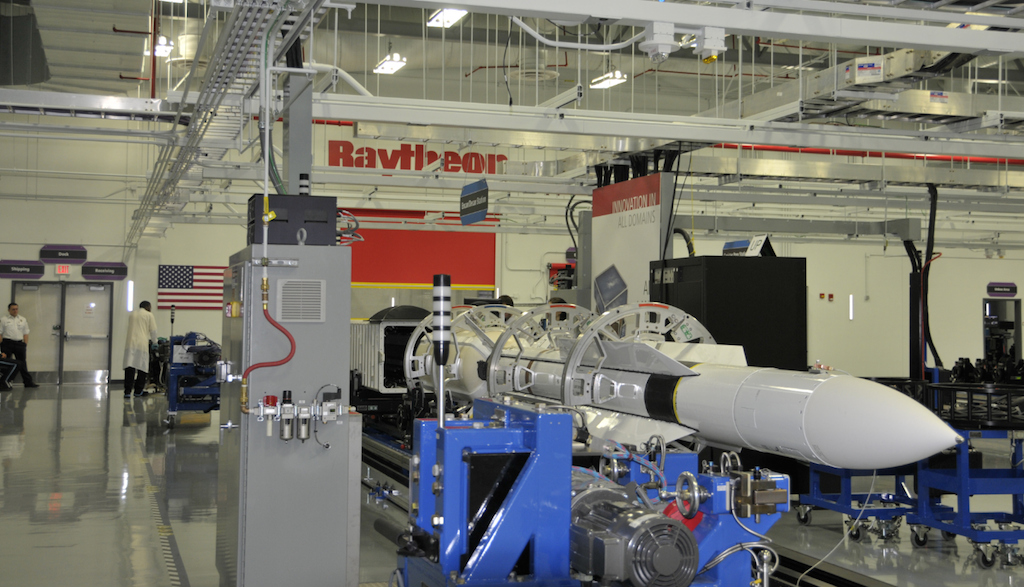
Vannevar Bush and Lawrence Marshall lived in the same room at Tufts Hostel. Lawrence decided to engage in the development of refrigeration devices. Since the technology of artificial cooling began to enter the industry, in the restaurant business, retail, it was decided to develop a refrigerator. But in reality it was not so simple ... and the newly established company in 1924 took up electronics. In the 20s, radio stations began to appear, radio became popular, but the first radio transmitters and radio receivers worked from two batteries, a simple A and a high-voltage B, their dimensions were impressive, field radio stations generally had to be carried on carts, civilians were expensive and their maintenance also flew in penny. The invention of the rectifier made it possible to connect the radio directly to the power grid, therefore, the size of the radio transmitters,
Beginning in 1925, Bush and a group of his staff built an integraf (Integraph) . The integragraph was a continuous machine that could solve 1st and 2nd order differential equations. This is how Bush described her at the time: "... an electric machine that can think for itself. In fact, it’s a man-made brain, the integrahe is designed to help a person cross the barrier of limited possibilities in finding solutions to complex mathematical problems."
Differential analyzer
Bush's work was devoted to creating devices that became popular in the 30s-40s — electromechanical differential analyzers, they preceded the advent of analog computers. In 1925, Bush’s graduate students, Herbert Stewart, King Gould and Harold Hazen, assembled a mechanical counting machine under Bush’s supervision to solve integrals, and they used the ideas of the Thomson brothers, who developed the first machine to predict tides in 1872–73. She allowed to predict the water level in the Thames, given the position of the Moon and the Sun, the daily rotation of the Earth and other parameters. The idea behind all mechanical tidal machines is harmonic analysis, which is this simple formula: the

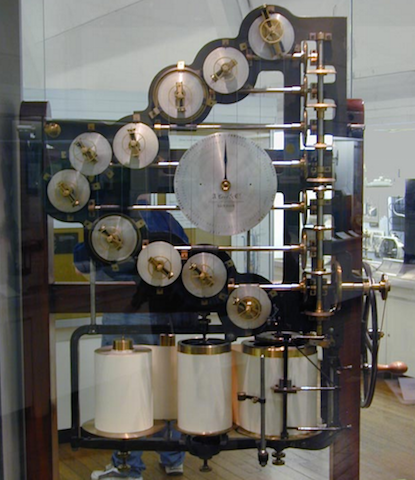
William Thomson tide prediction machine
Using such mechanical calculating machines as nodes, a machine was assembled to solve second-order differential equations. In the fall of 1931, such a device was called the Bush Differential Analyzer.

differential analyzer
Norbert Wiener wrote about Bush's differential analyzers, emphasizing that the values in such devices were represented, for example, by the angles of rotation of some axes and could be added together, multiplied, divided by each other, etc. In addition, these devices had a special device, called the integrating disk, which showed the final result obtained after performing all the necessary operations.
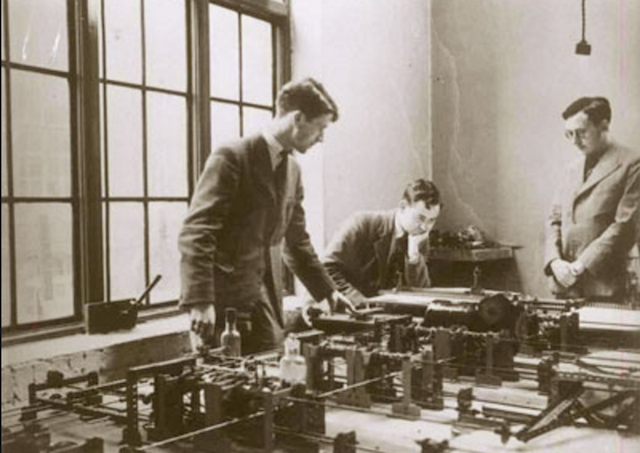
And so, what was such a differential analyzer. It was an electromechanical device, very reminiscent of a table for playing table football. The battery consisted of six integrators and allowed to solve one differential equation of the sixth order or two or three equations of the second order simultaneously. A sample of such a device, the Rockefeller Differential Analyzer, created in 1942, weighing 100 tons and entering information from a punched tape, contained two thousand electronic tubes, 150 motors and several thousand relays, which were connected by almost three hundred kilometers of wires. The integrators rotated servo motors with torque amplifiers so that the integrator discs would not slip under load.
The conditions of the equation to be solved were set by setting axles, cams and levers, additional physical parameters could be set using electric devices, a complex system of levers set in motion a pen drawing a curve for solving the equation on graph paper. The operator could also use the pen and at the entrance: to enter a curve into the system, so that the mechanics could put it into parameters. The instruments had a special device, called an integrating disk, which showed the final result. Such a machine was successfully used in some military projects during the Second World War, and Bush, thanks to his invention, became advisor to US President Franklin Roosevelt on science.
Bush’s machines were most likely the largest analog calculators in the world, quickly gained popularity and also quickly lost it. In the 30s of the last century, the differential analyzer was the most powerful computing device, research centers such as Cambridge, Oslo also made copies of this device. The process of working with such a machine was difficult and time consuming, preparation for solving the problem (most often from the field of electrical engineering) could take from one hundred to one thousand man-hours.
Later, Bush translates his electromechanical differential analyzer to electronic components. Analyzers began to be called analog computers. When designing and creating the well-known digital computer ENIAC, differential analyzers were used.
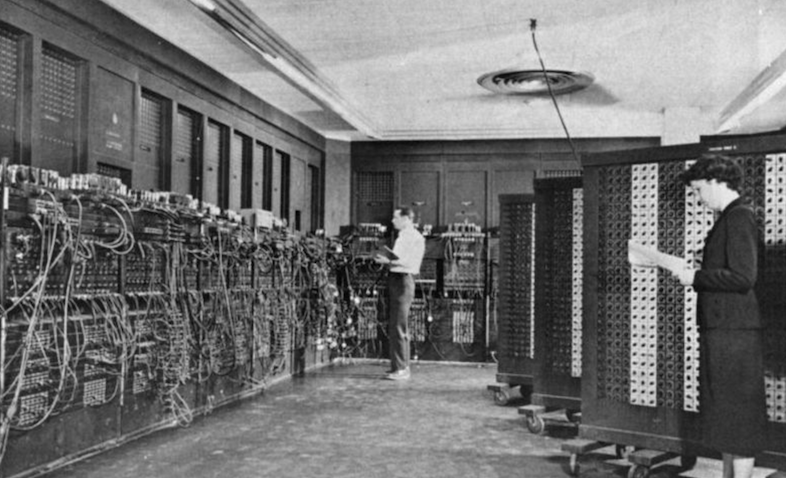
computer eniac
Vannevar Bush's differential analyzer has become a kind of transitional link to the creation of electronic digital computers. His student, undergraduate student Claude Shannon, in his master's thesis “Symbolic Analysis of Relays and Switching Circuits” (recognized as the most important thesis in history) showed the principles of creating logical electronic circuits, and created the theoretical basis of all modern electronics.
In 1932, Vannevar Bush became the head of the School of Engineering and vice president of MIT. In 1938 he was appointed to the post of head of the Carnegie Institution in Washington. In the same year, Bush develops, creates and patents a device for quickly finding information in microfilms.
An interesting fact is that on the threshold of World War II, in the summer of 1938, between the Anschluss of Austria and the occupation of Czechoslovakia by Germany, the FBI invited Bush to consult on the creation of a machine for breaking German ciphers, but, alas, Bush did not cope with this task. As you know, it was “mastered” in a couple of years by Alan Turing.
In 1939, Bush became the acting head of the National Aeronautics Council (NACA, from 1958, NASA). Bush insisted on creating a new laboratory in Sunnyvale (California), at the moment this laboratory has grown to become the largest center of space and computer research and is known as NASA.
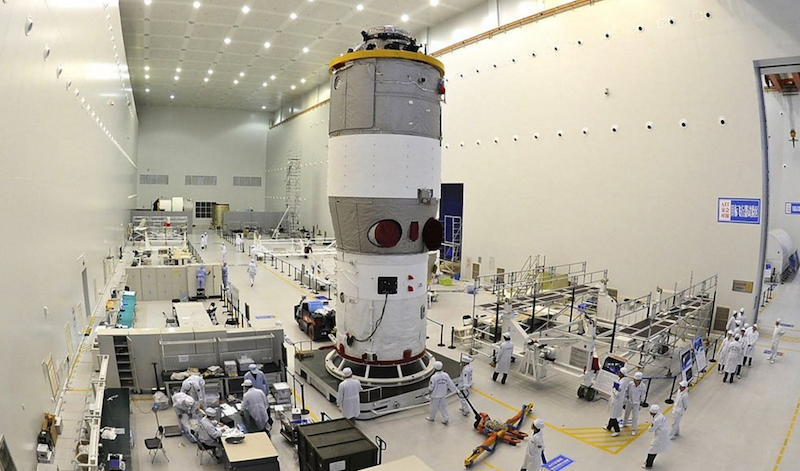

In 1940, Bush was appointed chairman of the State Defense Research Committee under the President of the United States. From 1941 - 1947 headed the Bureau of Research and Development at the US government. From 1939 to 1941, Bush served as chairman of the National Aeronautics Supervisory Board. He was a member of the Supreme Political Council, served as chairman of the Committee on Military Policy.
What connects Bush with modernity? The answer is found in his article “As we may think” (as long as we think), which was published in July 1945 in The Atlantic Monthly. This was the result of rethinking the role of science and scientists in the war and the history of society as a whole. Part of the article is reflections on the presentation of information. In it, he argues that paper forms of presenting information are far behind the level of requirements imposed by modern science. And ... "the archaism of information storage means that the most important results are unclaimed." Bush proposed a certain photo-electromechanical machine, which he himself called memex. It was never built, but it only figuratively helped to present an idea, the embodiment of which in our time was called hypertext.
Interesting
At MIT, the most secret division was created - the S-1 department, which was directly subordinate to Vannevar Bush. This department was not listed in any organizational plans; it was a uranium committee. This committee was set up by Bush less than 24 hours before Japan struck Pearl Harbor and Germany declared the US war. Although the project was not given much importance. The budget of the nuclear project was $ 6,000, and the work went on pure enthusiasm. So, having come under the authority of Vannevar Bush, the uranium committee was developed into a huge network of organizations. The committee was renamed the Manhattan Project.
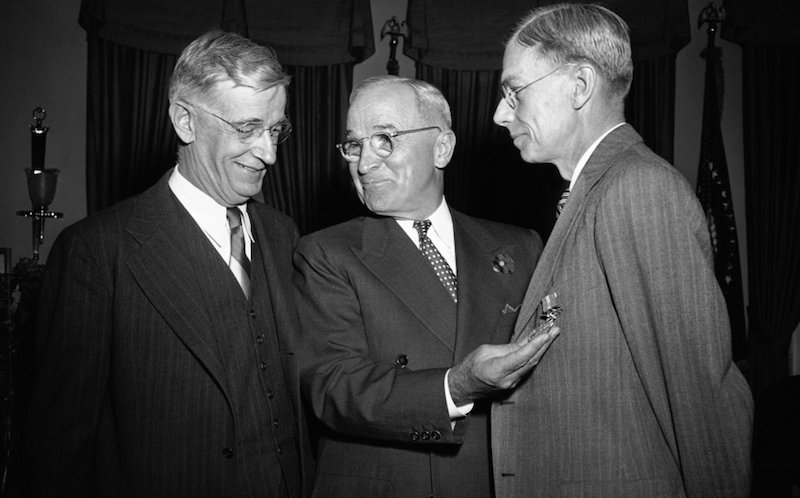
Harry Truman, James Bryant Conant and Vannevar Bush in the White House, 1948
Bush was an excellent leader, although he understood most of the projects under his leadership less than any of the researchers, but he knew how to create the conditions for successful work. He managed to achieve cooperation between researchers and the military. Bush inspired scientists and engineers, persuaded officers and led diplomatic games with Congress, the Senate and the White House, bearing in mind that the war would end soon and that a peaceful prospect had to be laid.
Memex in the concept of Bush is a machine of the type of a desk with screens where readable information is projected. All information should be stored in the form of microfilms, for which memex has microfiche reading subsystems and microfilming recording subsystems using the dry photo process. Such a machine seemed to Bush as a full-fledged workplace with a keyboard and auxiliary keys. Thanks to microfilm recording density, microfilm storage would be enough for a century if 5000 pages were recorded daily. That is, memex is a kind of hierarchical filing cabinet in which documents are connected by “traces”, through which it would be possible to move from one place to another. Users could read, mark up, annotate documents, share them and create new documents and tracks on new topics.

According to Bush:
Bush proposed a cross-reference mechanism similar to that used in modern hypertext, but implemented using a conditional mechanism. After all, with the help of auxiliary fields in the body of documents, it would be possible to reproduce the analogue of associative links that are inherent in human consciousness.
Back in 1939, Bush described a device that could facilitate working with microfilm. This alleged device is a bit like a modern action camera (GoPro). Here is how he described this device - a lens with a nut on his forehead, glasses with a grid-visor, a remote control on the wrist, a film cassette for a hundred frames with an electron-beam photosensor. This device can recognize voice in text, produce speech synthesis, do mathematical and logical transformations and perform data analysis.
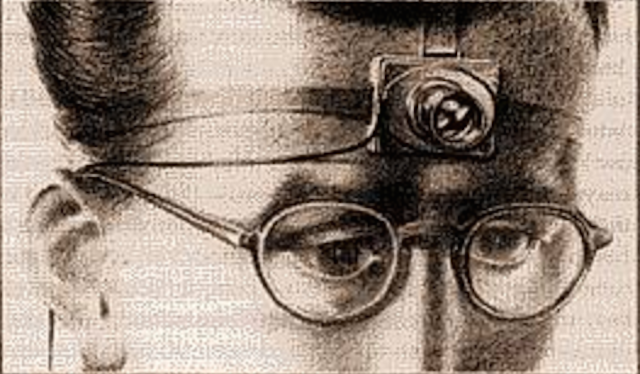
Vannevar Bush always considered himself an engineer, not a great scientist. He is a man of the project who "... says things" be, "and it arises." Being a very versatile person, the qualities of a mathematician and a practical engineer were harmoniously combined in him. As already mentioned, he created the most powerful computer before the advent of digital computers. Thanks to his influence, the engineering school of the Massachusetts Institute of Technology (MIT) was raised. He held a senior position in the US Department of Science, where penicillin, air-radars, remote detonators, and nuclear bomb were created. Bush figured out how to use machines to store knowledge. He foresaw the future. He is called the chief creator of nuclear weapons, the "general of physics", the great engineer, the humanist of the technocratic age.


What is known in the history of science Vannevar Bush?
The outstanding scientist, talented engineer and organizer, was the scientific adviser to President Roosevelt, this is what he wrote Norbert Wiener (American scientist, eminent mathematician and philosopher, founder of cybernetics and the theory of artificial intelligence):
Bush had not only a beautiful head, but also his hands, which, it seemed, were also capable of thinking. It was not for nothing that he was one of the most brilliant instrument engineers that America had ever known.
Differential analyzers, they also later analog computers, the first metex hypertext system, the National Science Foundation of the USA, the Raytheon company - all this (and not only) is associated with the name of the bright personality of Vannevar Bush.
A bit of biography
March 11, 1890 in the town of Everett (Massachusetts, USA) was born Vannevar Bush. The town has long been the center of the US whaling industry. The ancestors of Vannevar were associated with the whaling business, later, when this industry lost its importance, the whaling fleet was reduced, Bush's father, Richard Perry Bush, worked as a ship ship, and then left the fleet and became a Protestant priest.

Everett (Massachusetts USA)
In 1913, Bush graduated from Tufts College in Boston, following the example of his father, received an engineering degree, presenting a mechanical builder of surveying profiles to defend. In 1916, he received a degree from the Massachusetts Institute of Technology and Harvard University. Vannevar worked as an electrical engineer, and later, after his defense, he returned to Tufts as a teacher. Here he was caught by the First World War, during which he was engaged in the development of a magnetic detector of submarines. Alas, the device was never used, as it was designed for wooden ships. In 1916, Bush married Phoebe Davis.
In 1919, Bush went to the Massachusetts Institute of Technology, it was at this time that MIT became one of the leading international research centers.
In 1923 he received the title of professor of MIT, his first graduate student was Fred Terman. Radio engineer Fred Terman is known as the creator of Stanford, later - the godfather of Silicon Valley.
Raytheon can be considered the first achievement of Bush. Initially, it was a gas rectifier company for radio receivers, created together with Lawrence Marshall and Charles Smith. This is now Raytheon is one of the largest US missile companies.

Vannevar Bush and Lawrence Marshall lived in the same room at Tufts Hostel. Lawrence decided to engage in the development of refrigeration devices. Since the technology of artificial cooling began to enter the industry, in the restaurant business, retail, it was decided to develop a refrigerator. But in reality it was not so simple ... and the newly established company in 1924 took up electronics. In the 20s, radio stations began to appear, radio became popular, but the first radio transmitters and radio receivers worked from two batteries, a simple A and a high-voltage B, their dimensions were impressive, field radio stations generally had to be carried on carts, civilians were expensive and their maintenance also flew in penny. The invention of the rectifier made it possible to connect the radio directly to the power grid, therefore, the size of the radio transmitters,
Beginning in 1925, Bush and a group of his staff built an integraf (Integraph) . The integragraph was a continuous machine that could solve 1st and 2nd order differential equations. This is how Bush described her at the time: "... an electric machine that can think for itself. In fact, it’s a man-made brain, the integrahe is designed to help a person cross the barrier of limited possibilities in finding solutions to complex mathematical problems."
Differential analyzer
Bush's work was devoted to creating devices that became popular in the 30s-40s — electromechanical differential analyzers, they preceded the advent of analog computers. In 1925, Bush’s graduate students, Herbert Stewart, King Gould and Harold Hazen, assembled a mechanical counting machine under Bush’s supervision to solve integrals, and they used the ideas of the Thomson brothers, who developed the first machine to predict tides in 1872–73. She allowed to predict the water level in the Thames, given the position of the Moon and the Sun, the daily rotation of the Earth and other parameters. The idea behind all mechanical tidal machines is harmonic analysis, which is this simple formula: the


William Thomson tide prediction machine
Using such mechanical calculating machines as nodes, a machine was assembled to solve second-order differential equations. In the fall of 1931, such a device was called the Bush Differential Analyzer.

differential analyzer
Norbert Wiener wrote about Bush's differential analyzers, emphasizing that the values in such devices were represented, for example, by the angles of rotation of some axes and could be added together, multiplied, divided by each other, etc. In addition, these devices had a special device, called the integrating disk, which showed the final result obtained after performing all the necessary operations.

And so, what was such a differential analyzer. It was an electromechanical device, very reminiscent of a table for playing table football. The battery consisted of six integrators and allowed to solve one differential equation of the sixth order or two or three equations of the second order simultaneously. A sample of such a device, the Rockefeller Differential Analyzer, created in 1942, weighing 100 tons and entering information from a punched tape, contained two thousand electronic tubes, 150 motors and several thousand relays, which were connected by almost three hundred kilometers of wires. The integrators rotated servo motors with torque amplifiers so that the integrator discs would not slip under load.
The conditions of the equation to be solved were set by setting axles, cams and levers, additional physical parameters could be set using electric devices, a complex system of levers set in motion a pen drawing a curve for solving the equation on graph paper. The operator could also use the pen and at the entrance: to enter a curve into the system, so that the mechanics could put it into parameters. The instruments had a special device, called an integrating disk, which showed the final result. Such a machine was successfully used in some military projects during the Second World War, and Bush, thanks to his invention, became advisor to US President Franklin Roosevelt on science.
Bush’s machines were most likely the largest analog calculators in the world, quickly gained popularity and also quickly lost it. In the 30s of the last century, the differential analyzer was the most powerful computing device, research centers such as Cambridge, Oslo also made copies of this device. The process of working with such a machine was difficult and time consuming, preparation for solving the problem (most often from the field of electrical engineering) could take from one hundred to one thousand man-hours.
Later, Bush translates his electromechanical differential analyzer to electronic components. Analyzers began to be called analog computers. When designing and creating the well-known digital computer ENIAC, differential analyzers were used.

computer eniac
Vannevar Bush's differential analyzer has become a kind of transitional link to the creation of electronic digital computers. His student, undergraduate student Claude Shannon, in his master's thesis “Symbolic Analysis of Relays and Switching Circuits” (recognized as the most important thesis in history) showed the principles of creating logical electronic circuits, and created the theoretical basis of all modern electronics.
In 1932, Vannevar Bush became the head of the School of Engineering and vice president of MIT. In 1938 he was appointed to the post of head of the Carnegie Institution in Washington. In the same year, Bush develops, creates and patents a device for quickly finding information in microfilms.
An interesting fact is that on the threshold of World War II, in the summer of 1938, between the Anschluss of Austria and the occupation of Czechoslovakia by Germany, the FBI invited Bush to consult on the creation of a machine for breaking German ciphers, but, alas, Bush did not cope with this task. As you know, it was “mastered” in a couple of years by Alan Turing.
In 1939, Bush became the acting head of the National Aeronautics Council (NACA, from 1958, NASA). Bush insisted on creating a new laboratory in Sunnyvale (California), at the moment this laboratory has grown to become the largest center of space and computer research and is known as NASA.

Reflections on the presentation of information. Memex

In 1940, Bush was appointed chairman of the State Defense Research Committee under the President of the United States. From 1941 - 1947 headed the Bureau of Research and Development at the US government. From 1939 to 1941, Bush served as chairman of the National Aeronautics Supervisory Board. He was a member of the Supreme Political Council, served as chairman of the Committee on Military Policy.
What connects Bush with modernity? The answer is found in his article “As we may think” (as long as we think), which was published in July 1945 in The Atlantic Monthly. This was the result of rethinking the role of science and scientists in the war and the history of society as a whole. Part of the article is reflections on the presentation of information. In it, he argues that paper forms of presenting information are far behind the level of requirements imposed by modern science. And ... "the archaism of information storage means that the most important results are unclaimed." Bush proposed a certain photo-electromechanical machine, which he himself called memex. It was never built, but it only figuratively helped to present an idea, the embodiment of which in our time was called hypertext.
Interesting
At MIT, the most secret division was created - the S-1 department, which was directly subordinate to Vannevar Bush. This department was not listed in any organizational plans; it was a uranium committee. This committee was set up by Bush less than 24 hours before Japan struck Pearl Harbor and Germany declared the US war. Although the project was not given much importance. The budget of the nuclear project was $ 6,000, and the work went on pure enthusiasm. So, having come under the authority of Vannevar Bush, the uranium committee was developed into a huge network of organizations. The committee was renamed the Manhattan Project.

Harry Truman, James Bryant Conant and Vannevar Bush in the White House, 1948
The head of the project, the military builder General Leslie Groves, who had built the famous Pentagon in 1940, did not understand nuclear physics, but in the shortest time he built from scratch colossal secret objects, without which the required amount of heavy isotopes could not be obtained. This is how the uranium plant in Oak Ridge, the plutonium reactor in Hanford and the research center in Los Alamos (in the early years - a complex of temporary houses and modular two-story houses-barracks) arose.
Bush was an excellent leader, although he understood most of the projects under his leadership less than any of the researchers, but he knew how to create the conditions for successful work. He managed to achieve cooperation between researchers and the military. Bush inspired scientists and engineers, persuaded officers and led diplomatic games with Congress, the Senate and the White House, bearing in mind that the war would end soon and that a peaceful prospect had to be laid.
Memex in the concept of Bush is a machine of the type of a desk with screens where readable information is projected. All information should be stored in the form of microfilms, for which memex has microfiche reading subsystems and microfilming recording subsystems using the dry photo process. Such a machine seemed to Bush as a full-fledged workplace with a keyboard and auxiliary keys. Thanks to microfilm recording density, microfilm storage would be enough for a century if 5000 pages were recorded daily. That is, memex is a kind of hierarchical filing cabinet in which documents are connected by “traces”, through which it would be possible to move from one place to another. Users could read, mark up, annotate documents, share them and create new documents and tracks on new topics.

According to Bush:
On it are inclined transparent screens on which the material is projected for easy reading. There's also a keyboard and a set of buttons and levers. Otherwise, it looks like an ordinary desk ... memex should work not as a hierarchical filing cabinet, but, like memory, on associative links
Bush proposed a cross-reference mechanism similar to that used in modern hypertext, but implemented using a conditional mechanism. After all, with the help of auxiliary fields in the body of documents, it would be possible to reproduce the analogue of associative links that are inherent in human consciousness.
Back in 1939, Bush described a device that could facilitate working with microfilm. This alleged device is a bit like a modern action camera (GoPro). Here is how he described this device - a lens with a nut on his forehead, glasses with a grid-visor, a remote control on the wrist, a film cassette for a hundred frames with an electron-beam photosensor. This device can recognize voice in text, produce speech synthesis, do mathematical and logical transformations and perform data analysis.

Vannevar Bush always considered himself an engineer, not a great scientist. He is a man of the project who "... says things" be, "and it arises." Being a very versatile person, the qualities of a mathematician and a practical engineer were harmoniously combined in him. As already mentioned, he created the most powerful computer before the advent of digital computers. Thanks to his influence, the engineering school of the Massachusetts Institute of Technology (MIT) was raised. He held a senior position in the US Department of Science, where penicillin, air-radars, remote detonators, and nuclear bomb were created. Bush figured out how to use machines to store knowledge. He foresaw the future. He is called the chief creator of nuclear weapons, the "general of physics", the great engineer, the humanist of the technocratic age.

